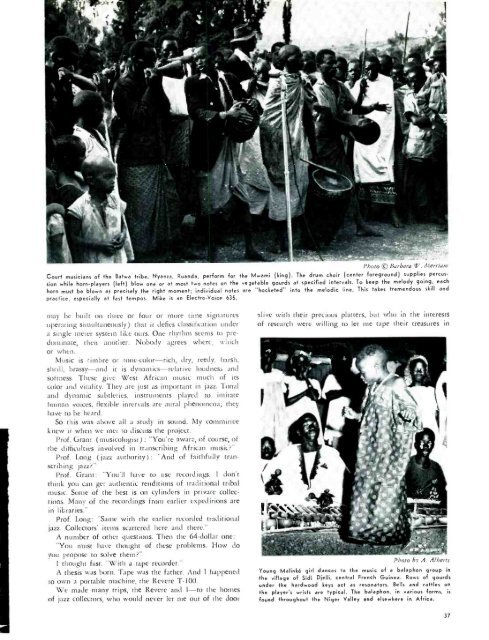Tape Recording Magazine - AmericanRadioHistory.Com
Tape Recording Magazine - AmericanRadioHistory.Com
Tape Recording Magazine - AmericanRadioHistory.Com
You also want an ePaper? Increase the reach of your titles
YUMPU automatically turns print PDFs into web optimized ePapers that Google loves.
Photo © Barbara W. Merriam<br />
Court musicians of the Batwa tribe, Nyanza, Ruanda, perform for the Mwami (king). The drum choir (center foreground) supplies percussion<br />
while horn -players (left) blow one or at most two notes on the vegetable gourds at specified intervals. To keep the melody going, each<br />
horn must be blown at precisely the right moment; individual notes are "hocketed" into the melodic line. This takes tremendous skill and<br />
practice, especially at fast tempos. Mike is an Electro -Voice 635.<br />
may be built on three or four or more time signatures<br />
operating simultaneously) that it defies classification under<br />
a single meter system like ours. One rhythm seems to predominate,<br />
then another. Nobody agrees where, which<br />
or when.<br />
Music is timbre or tone -color -rich, dry, reedy, harsh,<br />
shrill, brassy -and it is dynamics -relative loudness and<br />
softness. These give West African music much of its<br />
color and vitality. They are just as important in jazz. Tonal<br />
and dynamic subtleties, instruments played to imitate<br />
human voices, flexible intervals are aural phenomena; they<br />
have to be heard.<br />
So this was above all a study in sound. My committee<br />
knew it when we met to discuss the project.<br />
Prof. Grant ( musicologist) : "You're aware, of course, of<br />
the difficulties involved in transcribing African music ?"<br />
Prof. Long ( jazz authority) : "And of faithfully transcribing<br />
jazz ?"<br />
Prof. Grant: "You'll have to use recordings. I don't<br />
think you can get authentic renditions of traditional tribal<br />
music. Some of the best is on cylinders in private collections.<br />
Many of the recordings from earlier expeditions are<br />
in libraries."<br />
Prof. Long: "Same with the earlier recorded traditional<br />
jazz. Collectors' items scattered here and there."<br />
A number of other questions. Then the 64- dollar one:<br />
"You must have thought of these problems. How do<br />
you propose to solve them ?"<br />
I thought fast. "With a tape recorder."<br />
A thesis was born. <strong>Tape</strong> was the father. And I happened<br />
to own a portable machine, the Revere T -I00.<br />
We made many trips, the Revere and I -to the homes<br />
of jazz collectors, who would never let me out of the door<br />
alive with their precious platters, but who in the interests<br />
of research were willing to let me tape their treasures in<br />
Photo by A. Alberts<br />
Young Malinké girl dances to the music of a balaphon group in<br />
the village of Sidi Djelli, central French Guinea. Rows of gourds<br />
under the hardwood keys act as resonators. Bells and rattles on<br />
the player's wrists are typical. The balaphon, in various forms, is<br />
found throughout the Niger Valley and elsewhere in Africa.<br />
37
















